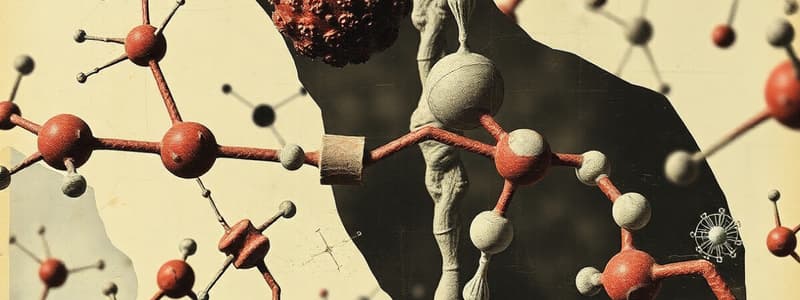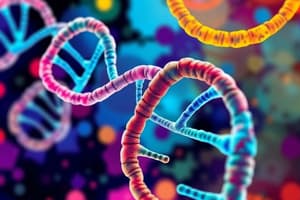Podcast
Questions and Answers
What type of bond is formed when electrons are shared between atoms of similar electronegativities?
What type of bond is formed when electrons are shared between atoms of similar electronegativities?
- Hydrogen bond
- Ionic bond
- Van der Waals bond
- Covalent bond (correct)
Which monomer links to form polysaccharides through glycosidic bonds?
Which monomer links to form polysaccharides through glycosidic bonds?
- Monosaccharide (correct)
- Fatty acid
- Amino acid
- Nucleotide
What is the function of proteins as organic macromolecules?
What is the function of proteins as organic macromolecules?
- Provide insulation
- Structure, transport, and defense (correct)
- Store energy
- Encoding genetic information
Which type of molecular bond is characterized by a weak attraction between a hydrogen atom and an electronegative atom?
Which type of molecular bond is characterized by a weak attraction between a hydrogen atom and an electronegative atom?
What process utilizes water to break polymers into monomers?
What process utilizes water to break polymers into monomers?
What is the primary component of triglycerides?
What is the primary component of triglycerides?
Which of the following best describes saturated fatty acids?
Which of the following best describes saturated fatty acids?
What is the main function of polysaccharides?
What is the main function of polysaccharides?
Which component is part of phospholipids?
Which component is part of phospholipids?
Which nitrogenous base is found in RNA but not in DNA?
Which nitrogenous base is found in RNA but not in DNA?
What kind of bond structure characterizes unsaturated fats?
What kind of bond structure characterizes unsaturated fats?
What is a primary structure of proteins?
What is a primary structure of proteins?
What is the significance of the deoxyribose sugar in DNA?
What is the significance of the deoxyribose sugar in DNA?
What type of secondary structure involves local folding into α-helices and β-sheets?
What type of secondary structure involves local folding into α-helices and β-sheets?
Which base pairs are held together by 3 hydrogen bonds?
Which base pairs are held together by 3 hydrogen bonds?
Which of the following statements about porphyrins is true?
Which of the following statements about porphyrins is true?
What is the main difference between RNA and DNA in terms of their base composition?
What is the main difference between RNA and DNA in terms of their base composition?
Which statement about the stability of GC base pairs is correct?
Which statement about the stability of GC base pairs is correct?
What type of bonding occurs between the amino and carboxyl groups of adjacent amino acids in protein structures?
What type of bonding occurs between the amino and carboxyl groups of adjacent amino acids in protein structures?
Which of the following is an example of a molecule associated with lipid membranes, even though it's not a lipid?
Which of the following is an example of a molecule associated with lipid membranes, even though it's not a lipid?
Flashcards
Ionic Bond
Ionic Bond
A chemical bond where electrons are transferred between atoms of very different electronegativity.
Covalent Bond
Covalent Bond
A chemical bond formed by the sharing of electrons.
Hydrogen Bond
Hydrogen Bond
A weak bond formed between a hydrogen atom and an electronegative atom like oxygen or nitrogen.
Hydrolysis
Hydrolysis
Signup and view all the flashcards
Macromolecule
Macromolecule
Signup and view all the flashcards
Triglycerides
Triglycerides
Signup and view all the flashcards
Disaccharides
Disaccharides
Signup and view all the flashcards
Saturated fatty acid
Saturated fatty acid
Signup and view all the flashcards
Unsaturated fatty acid
Unsaturated fatty acid
Signup and view all the flashcards
Phospholipids
Phospholipids
Signup and view all the flashcards
Steroids
Steroids
Signup and view all the flashcards
Primary protein structure
Primary protein structure
Signup and view all the flashcards
DNA structure
DNA structure
Signup and view all the flashcards
Alpha helix
Alpha helix
Signup and view all the flashcards
Beta sheet
Beta sheet
Signup and view all the flashcards
Tertiary structure
Tertiary structure
Signup and view all the flashcards
Quaternary structure
Quaternary structure
Signup and view all the flashcards
Polymer
Polymer
Signup and view all the flashcards
Nucleotide
Nucleotide
Signup and view all the flashcards
Study Notes
Atoms & Molecules
- Atoms are the fundamental unit of matter, composed of neutrons, protons, and electrons
- Molecules are groups of two or more atoms held together by chemical bonds.
- Macromolecules are large molecules formed from smaller units (monomers).
Types of Molecular Bonds
- Ionic bonds form when one atom transfers an electron to another, creating oppositely charged ions.
- Covalent bonds form when atoms share electrons. Nonpolar bonds share equally, polar bonds share unequally.
- Hydrogen bonds are weak attractions between a hydrogen atom of one molecule and a highly electronegative atom of another (e.g., oxygen or nitrogen).
Formation of Macromolecules
- Dehydration reactions link monomers together to form polymers, releasing a water molecule.
- Hydrolysis reactions break polymers into monomers by adding water.
The 4 Types of Organic Macromolecules
Proteins
- Monomer: Amino acid
- Polymer: Peptide
- Linkage type: Peptide bonds
- Function: Structure, transport, defense, storage, enzymes, etc.
- Structures (primary, secondary, tertiary, quaternary) are determined by amino acid sequences and interactions.
Carbohydrates
- Monomer: Monosaccharide
- Polymer: Polysaccharide
- Linkage type: Glycosidic bonds
- Function: Store energy.
- Types: Monosaccharides, disaccharides, polysaccharides (e.g., starch, glycogen, cellulose)
Lipids
- Monomer: Fatty acids (hydrocarbon chains) and glycerol
- Polymer: Triglycerides, phospholipids, steroids, porphyrins
- Function: Insulation, energy storage, endocrine signaling, cell structure.
- Types: Triglycerides, phospholipids, steroids, porphyrins
Nucleic Acids
- Monomer: Nucleotide
- Polymer: Nucleic acid (DNA, RNA)
- Linkage type: Phosphodiester bonds
- Function: Encode, store, and express genetic information.
- Structures: DNA (double helix) and RNA (single helix). Each nucleotide has a base (A, T, C, G, or U), a sugar (deoxyribose or ribose), and a phosphate group. Base pairing (A-T and G-C) in DNA.
Studying That Suits You
Use AI to generate personalized quizzes and flashcards to suit your learning preferences.




